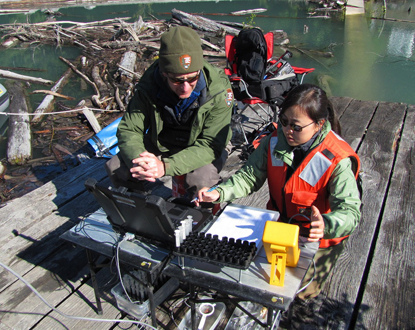|
You are viewing ARCHIVED content published online before January 20, 2025.
Please note that this content is NOT UPDATED, and links may not work. For current information,
visit https://www.nps.gov/aboutus/news/index.htm.

NPS photo by John Gussman
Contact: Dave Reynolds, 360-457-0715 Contact: Paul Laustsen, 650-329-4013 Contact: Doug Zimmer, 360-753-4370 Fisheries biologists from Olympic National Park and partner
agencies completed elements of the park’s Bull Trout Protection and Restoration
Plan June 17. Scientists used both hook-and-line and electrofishing
sampling techniques to capture 82 juvenile and adult bull trout over the course
of ten days, working in the vicinity of Lake Mills and the middle Elwha River
in Olympic National Park. The fish were held in live pens in Lake Mills until June 17,
when the fish were relocated via four helicopter flights to two upstream
locations, near Elkhorn Ranger Station and at the mouth of the Hayes River.
Prior to their release back into the upper river, the fish were genetically
sampled and measured. Captured fish averaged 14 inches in length, with some
fish measuring up to 24 inches. Thirty-one of the fish were fitted with radio
transmitters, which will allow fisheries managers to track the relative success
of moving fish into the upper Elwha Valley. Beginning in mid-September, contractors will begin to remove
the Elwha and Glines Canyon Dams. As dam removal begins and the Lake Aldwell
and Lake Mills reservoirs drain, the river will begin to erode large amounts of
sediment that has accumulated in the reservoirs since dam construction. The
Bureau of Reclamation estimates more than 24 million cubic yards of sediment is
now stored in the reservoirs, a majority (20.3 million cubic yards) as a delta
at the south end of Lake Mills. High levels of sediment in the lower river
would have an adverse and potentially lethal effect on fish. With the Lake Mills reservoir recognized as a stronghold for
bull trout in the Elwha River system, implementation of the plan fulfills a
requirement outlined in a 2000 revision to the 1996 U.S. Fish and Wildlife
Service Biological Opinion on the Elwha River Restoration project. Bull trout (Salvelinus confluentus) were first
listed as a threatened species under the Endangered Species Act in 1999. “Using the best available science, we’ve taken steps to
protect the bull trout population and given them immediate access to high-quality,
pristine habitats in the upper river through this relocation project,” Olympic
National Park fisheries biologist Sam Brenkman said. Over the last five years, fisheries biologists have
conducted a number of key studies in order to protect bull trout during dam
removal. These efforts include the tracking of fish via radio telemetry, two
headwaters-to-mouth (45-mile) snorkel surveys and genetic studies. Based on this work, the adult bull trout population is
estimated to be less than 400 fish. Riverscape snorkel surveys conducted in
2007 and 2008 indicate that bull trout represent approximately three percent of
the entire Elwha River fish community. Between 60 – 69 percent of the observed
bull trout occur from Rica Canyon downstream, which includes Lake Mills. “We are pleased that we met our objectives, and this
project, designed to protect a threatened species, would not have been
possible without close collaboration among the various agencies,” Olympic
National Park fisheries biologist Pat Crain said. “During two weeks of field
work, more than 20 biologists—from the U.S. Fish and Wildlife Service, U.S.
Geological Survey, National Oceanic and Atmospheric Administration, Lower Elwha Klallam Tribe, Washington Department of
Fish and Wildlife, and Student Conservation Association—assisted with and
monitored the capture and relocation effort.” In addition to the upriver relocation, Olympic National Park
has undertaken additional means to protect bull trout and remove barriers to
fish migration. Last year, an undersized, fish-blocking culvert on Griff Creek
was replaced with a 26-foot bottomless culvert that will allow bull trout and
other migratory fish species access to this important middle river tributary.
Fisheries biologists at the park are also engaged in an extensive evaluation of
non-native brook trout in the watershed, as they are known to compete with and
sometimes interbreed with bull trout. For more information on the life history and population
distribution of bull trout in the Elwha River, please visit www.nps.gov/olym/naturescience/bull-trout.htm.
To read the Bull Trout Protection and Restoration Plan, see www.nps.gov/olym/naturescience/elwha-restoration-docs.htm. # # # # |
Last updated: February 28, 2015
